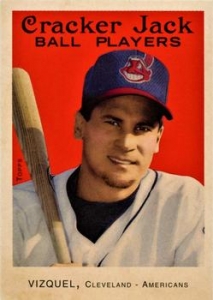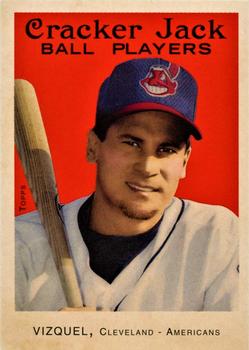July 10, 1999: Vizquel’s walk-off home run salvages Candiotti’s return to Cleveland
 The Cleveland Indians hosted the Cincinnati Reds on the afternoon of July 10, 1999, before a packed house of 43,127 fans at Jacobs Field for the second of three mid-July games in the annual Battle of Ohio.
The Cleveland Indians hosted the Cincinnati Reds on the afternoon of July 10, 1999, before a packed house of 43,127 fans at Jacobs Field for the second of three mid-July games in the annual Battle of Ohio.
The Indians were the best team in baseball at 55-30. Even though they had won only half of their previous 18 games, their division lead had increased to 12 games during that stretch. The second-place White Sox, a .500 club, were as close as any team would get to Cleveland for the remainder of the 1999 season.
What the Indians lacked, however, was a fifth starter. In a season where nominal fifth starter Dwight Gooden would produce a 6.26 ERA in 22 starts, the Indians turned back the clock this weekend with an old name – Tom Candiotti.
Candiotti’s last starting assignment in 1999 had come more than a month before, on June 2, when he was still with the Oakland Athletics, but he was released two weeks later and was picked up by Cleveland at the end of June. It was a return to the team with which he had found his first big-league success, starting 172 games between 1986 and 1991. He was making his first start for the Indians in just over eight years, when he had faced the Blue Jays on June 23, 1991, and was traded to Toronto four days later along with Turner Ward for three young Jays who would see some time in Cleveland: Mark Whiten, Glenallen Hill, and Denis Boucher.
The visiting Cincinnati Reds were in a more precarious position, sitting only a half-game ahead of the second-place Houston Astros at 48-35. The Reds had not finished higher than third in the National League Central Division since their last playoff appearance in 1995 resulted in a four-game NLCS sweep at the hands of the Atlanta Braves. Lefty Ron Villone, cut by the Indians at the end of spring training, would start against his former team.
The game was a slugfest from the outset. Pokey Reese, playing shortstop in place of All-Star Barry Larkin, who was getting his first day off of the season,1 led off the game with a walk, went to second on a wild pitch, and scored on a double by Jeffrey Hammonds. Then a one-out home run by Greg Vaughn staked the Reds to a 3-0 lead.
The Indians struck back for four runs in the bottom of the second off Villone, with a a two-run triple by Pat Borders and run-scoring singles by Jacob Cruz and Enrique Wilson.
Candiotti gave it all back in the third as the Reds, with three singles, another wild pitch by Candiotti, and two-out doubles by Mike Cameron and Jason LaRue put the Reds back on top, 7-4, and interrupted Candiotti’s return to the rotation after 63 pitches with seven earned runs allowed on seven hits in 2⅓ innings pitched. The man he had temporarily replaced in the rotation, Dwight Gooden, came on in relief but fared no better.
After Villone set the Indians down in the third and fourth innings, the Reds made it 9-4 with two runs off Gooden in the fifth on a pair of walks, three stolen bases, and a two-run double by Reese.
The Indians trailed 9-5 in the bottom of the seventh when Manny Ramirez hit a leadoff homer against reliever Scott Sullivan. Three batters later Jim Thome homered off Gabe White with a man on base to put the Indians within a run, 9-8. Ramirez homered again with two outs in the bottom of the eighth off Reds closer Danny Graves and the game was tied, 9-9. It was Ramirez’s 25th home run of the season and his 94th RBI.
Indians manager Mike Hargrove went to his closer, Michael Jackson, in the top of the ninth. He walked leadoff batter Cameron, who stole second –his third stolen base of the game – and scored on a two-out single by Reese. It was 10-9, Reds, going into the bottom of the ninth. But the Indians were not done.
Graves walked leadoff man Thome on a full count to start the inning and was replaced by rookie Scott Williamson, who was having a brilliant season. The 23-year-old from Oklahoma State University entered the game with a 7-3 record, 11 saves, and a 1.53 ERA in 59 innings. He had been named to the coming All-Star Game in Boston and would go on to win the 1999 NL Rookie of the Year award. He would not close the door this day, however.
Thome was replaced by pinch-runner John McDonald and Kenny Lofton, pinch-hitting for Borders, sacrificed McDonald to second base. Williamson struck out Cruz on three pitches, bringing up shortstop Omar Vizquel.
The 32-year-old Vizquel, a defensive wizard who had collected Gold Gloves for his play at shortstop the last six seasons and would earn five more in his career, was enjoying his finest offensive season. He entered the day batting .325 and would finish the season with an .833 OPS, the only season of his career that he finished above .800.
On the second pitch of the at-bat, Vizquel popped a fly ball toward the right field corner that Michael Tucker had a bead on.
“Let’s check their bats. I thought it was a popup, a routine popup. I didn’t think a little guy could hit a low-and-away pitch like that,” Williamson said after the game.2 Vizquel almost concurred: “I didn’t hit it that well. But I saw Tucker running back and back. He was playing so shallow. I thought I would have had a good chance for a triple if it hit the wall. So I kept running until someone stopped me.”3
Tucker ran out of room, and the ball sailed just over the fence into the second or third row of the stands for a game-winning two-run home run. It was just Vizquel’s third homer of the season, and it sent the Indians off with an 11-10 victory. The Indians had trailed 3-0 in the second and 9-4 in the fifth, and were down to their last out in the ninth, but the 27th out proved too difficult for Williamson and the Reds.
The Indians continued to put up gaudy offensive numbers in 1999, scoring 1,009 runs4 and winning 97 games en route to their fifth straight division title which they took by 21½ games over the second-place White Sox. Manny Ramirez hit 44 home runs and led the American League with 165 RBIs, setting a franchise record in the process. But the Indians fell to the Boston Red Sox in the American League Division Series, spelling the end of Hargrove’s nine-year run as Indians manager.
Candiotti would next start on July 23 at Yankee Stadium, allowing five runs before yielding in the second inning. It was the 410th and last start of his 16-year career.
The Reds’ own playoff hunt came up short in 1999; they finished 96-67 but trailed the Houston Astros by 1½ games in the National League Central Division.
Author’s Note
The summer of 1999 bridged my freshman and sophomore years at Case Western Reserve University, and I took the opportunity to get paid to watch as much baseball as I could handle. I ushered nearly every game that season, taking the Red Line to the ballpark, and watched the ninth inning of this game kneeling just behind the Indians’ dugout on the third-base side. Tucker came so close to catching the ball that we all held our breath for a beat until it was apparent the ball had gone just over the wall. Then, pandemonium.
Sources
baseball-reference.com/boxes/CLE/CLE199907100.shtml
retrosheet.org/boxesetc/1999/B07100CLE1999.htm
Notes
1 Chris Haft and John Fay, “Reds Report,” Cincinnati Enquirer, July 11, 1999: D5.
2 Sheldon Ocker, “Vizquel Vanquishes Reds,” Akron Beacon Journal, July 11, 1999: D1.
3 John Fay, “Small Vizquel Proves to Be Big-Time Player,” Cincinnati Enquirer, July 11, 1999: D5.
4 Only seven teams since 1901 have scored 1,000 runs and as of 2020 the 1999 Indians remain the only team since the 1950 Boston Red Sox to have done so.
Additional Stats
Cleveland Indians 11
Cincinnati Reds 10
Jacobs Field
Cleveland, OH
Box Score + PBP:
Corrections? Additions?
If you can help us improve this game story, contact us.


